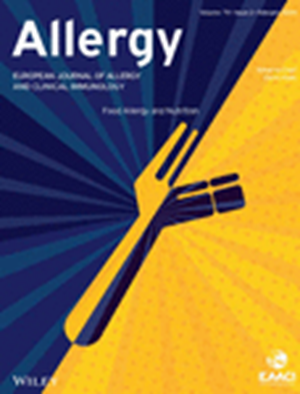Acetylcholine From Solitary Chemosensory Cell, Not Neuron, Regulates Basal Cell Fate Driving Eosinophilic Chronic Rhinosinusitis With Nasal Polyps.
IF 12
1区 医学
Q1 ALLERGY
引用次数: 0
Abstract
BACKGROUND Basal cells (BCs) play a crucial role in epithelial remodeling, a hallmark of eosinophilic chronic rhinosinusitis with nasal polyps (eCRSwNP). Single-cell sequencing has revealed an increased number of solitary chemosensory cells (SCCs) alongside BC hyperplasia in eCRSwNP, yet the underlying mechanism of BC hyperplasia in eCRSwNP remains unclear. This study aimed to investigate the role of SCC-derived acetylcholine (Ach) in determining BC fate. METHODS Tissue samples from healthy individuals, patients with eCRSwNP, and those with non-eCRSwNP (neCRSwNP) were analyzed to investigate BC proliferation, differentiation abnormalities, and the prevalence of SCCs. The relationship between SCC-derived Ach, BC dysfunction, and disease severity was examined. Ach sources and receptor expression patterns were characterized. In vitro studies using submerged cell cultures and air-liquid interface cultures, along with in vivo murine models, were employed to elucidate the mechanisms by which Ach influences BC fate. The inhibitory effects of tiotropium bromide (TB) on Ach-driven processes were also evaluated. RESULTS Our results indicated that SCC-derived Ach, rather than by parasympathetic nerves, contributed to abnormal BC proliferation and differentiation through muscarinic acetylcholine receptors (mAChRs) and had potential impact on the development of eCRSwNP. These effects were associated with the activation of YAP and could be partially reversed both in vitro and in vivo by blocking mAChRs with TB. CONCLUSION These results demonstrate that SCC-derived Ach plays a critical role in eCRSwNP by regulating BC fate. This provides a potential translational framework for developing prevention and treatment strategies targeting the cholinergic pathway.来自孤立化学感觉细胞而非神经元的乙酰胆碱调节基底细胞命运驱动嗜酸性慢性鼻窦炎伴鼻息肉。
背景:基底细胞(bc)在上皮重塑中起着至关重要的作用,这是嗜酸性慢性鼻窦炎伴鼻息肉(eCRSwNP)的一个标志。单细胞测序显示,在eCRSwNP中,随着BC增生,孤立化学感觉细胞(SCCs)数量增加,但eCRSwNP中BC增生的潜在机制尚不清楚。本研究旨在探讨scc衍生乙酰胆碱(Ach)在决定BC预后中的作用。方法分析健康个体、eCRSwNP患者和非eCRSwNP患者(neCRSwNP)的组织样本,研究BC增殖、分化异常和SCCs的患病率。研究了scc源性乙酰胆碱、BC功能障碍和疾病严重程度之间的关系。分析了乙酰胆碱来源及受体表达模式。体外研究采用浸没细胞培养和气液界面培养,以及体内小鼠模型,以阐明Ach影响BC命运的机制。并对噻托溴铵(TB)对乙酰胆碱驱动过程的抑制作用进行了评价。结果scc来源的乙酰胆碱受体(mAChRs)介导异常BC增殖和分化,而非副交感神经,并对eCRSwNP的发展有潜在影响。这些作用与YAP的激活有关,并且可以通过结核阻断machr在体外和体内部分逆转。结论scc来源的Ach通过调节BC的命运在eCRSwNP中起关键作用。这为开发针对胆碱能途径的预防和治疗策略提供了潜在的翻译框架。
本文章由计算机程序翻译,如有差异,请以英文原文为准。
求助全文
约1分钟内获得全文
求助全文
来源期刊

Allergy
医学-过敏
CiteScore
26.10
自引率
9.70%
发文量
393
审稿时长
2 months
期刊介绍:
Allergy is an international and multidisciplinary journal that aims to advance, impact, and communicate all aspects of the discipline of Allergy/Immunology. It publishes original articles, reviews, position papers, guidelines, editorials, news and commentaries, letters to the editors, and correspondences. The journal accepts articles based on their scientific merit and quality.
Allergy seeks to maintain contact between basic and clinical Allergy/Immunology and encourages contributions from contributors and readers from all countries. In addition to its publication, Allergy also provides abstracting and indexing information. Some of the databases that include Allergy abstracts are Abstracts on Hygiene & Communicable Disease, Academic Search Alumni Edition, AgBiotech News & Information, AGRICOLA Database, Biological Abstracts, PubMed Dietary Supplement Subset, and Global Health, among others.
 求助内容:
求助内容: 应助结果提醒方式:
应助结果提醒方式:


